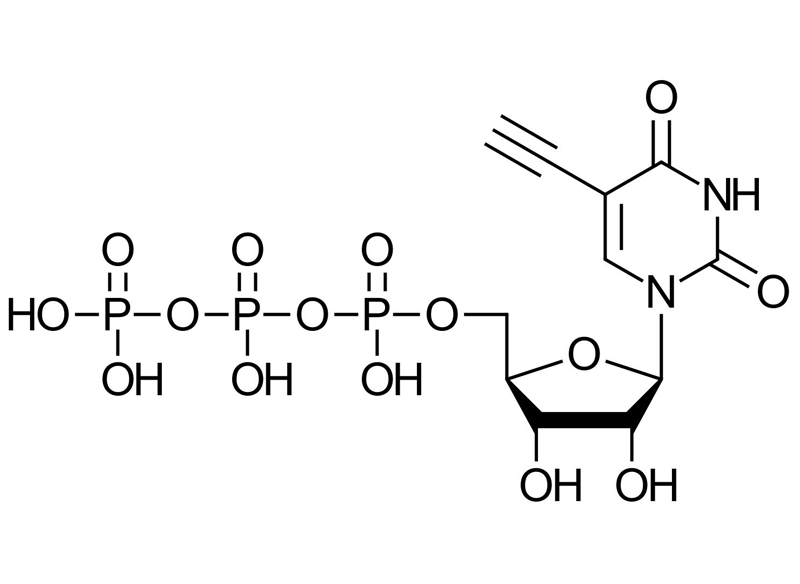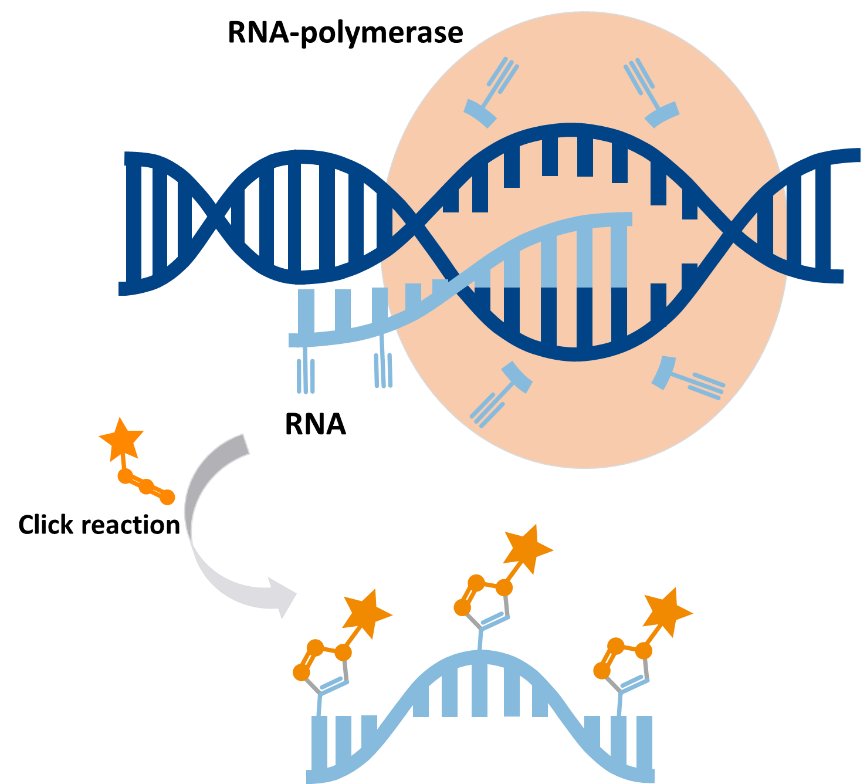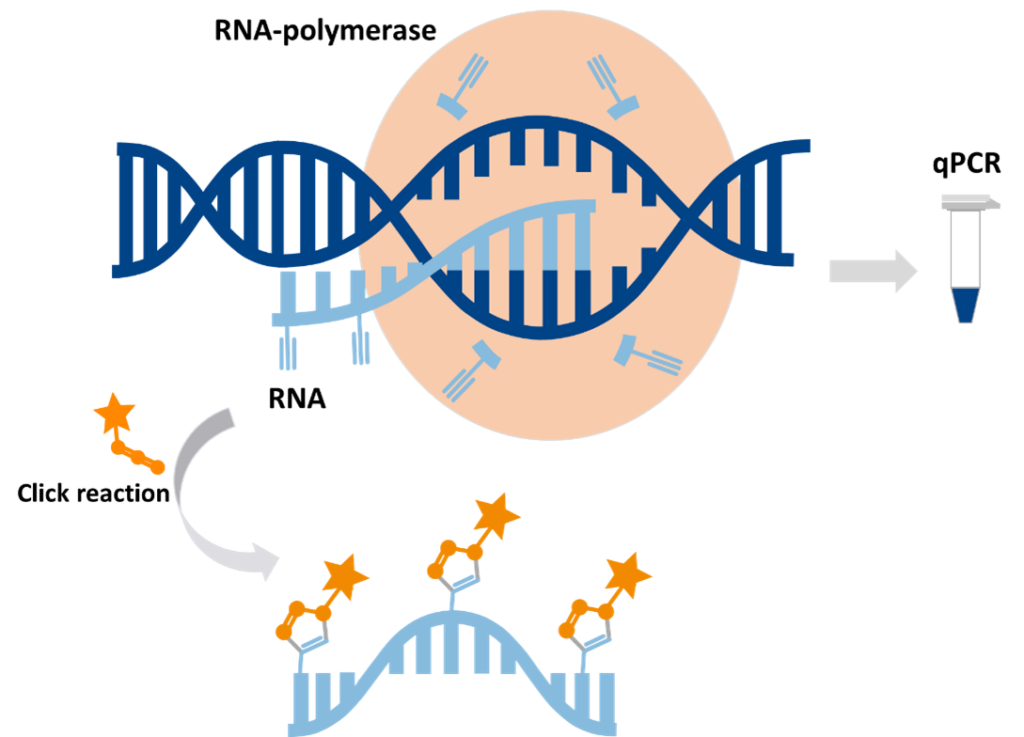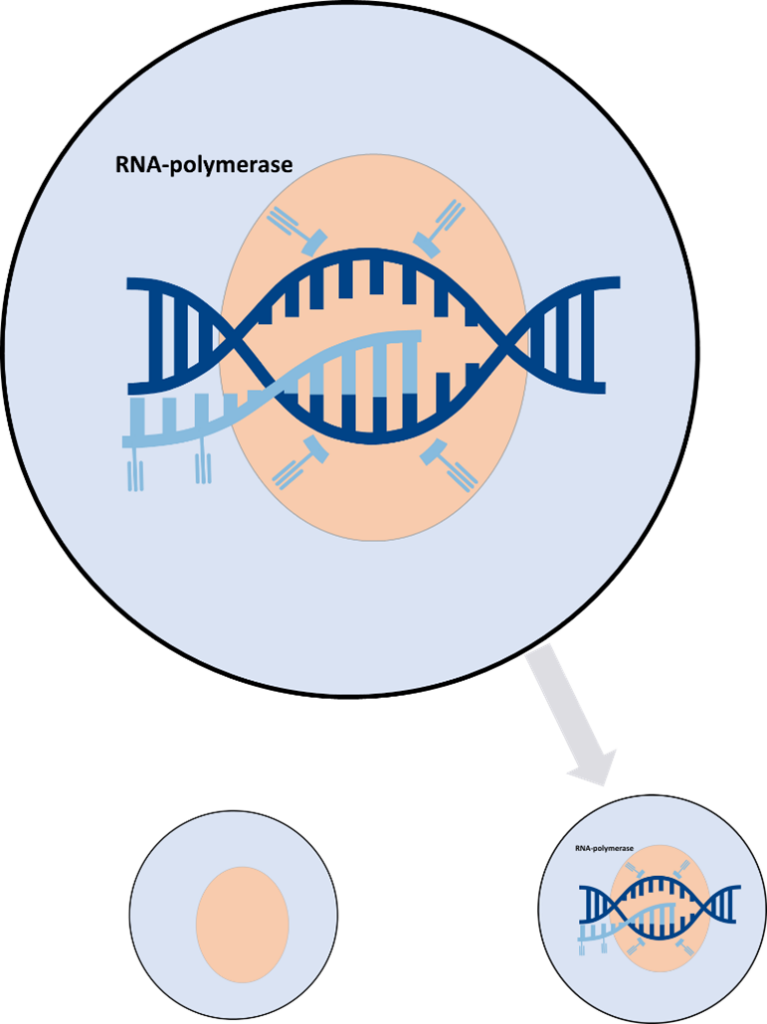5-Ethynyl-UTP (5-EUTP)
A bioorthogonal nucleotide analog for RNA labeling via click chemistry

| Size | Catalog No. | Price |
|---|---|---|
| 1 µmol | BCT-07-S | € 320,00 |
| 5 µmol | BCT-07-L | € 1.200,00 |
-
The role of 5-Ethynyl-UTP in real-time visualization and quantification
5-Ethynyl-UTP (5-EUTP) is a chemically modified nucleotide analog of uridine triphosphate (UTP), featuring an ethynyl group at the 5-position of the uracil base.
During in vitro transcription, RNA polymerases efficiently incorporate 5-EUTP into RNA, introducing reactive alkyne group that enables selective post transcriptional tagging using bioorthogonal click chemistry, particularly copper(I)-catalyzed azide-alkyne cycloaddition (CuAAC).
This innovation allows you to fluorescently or chemically label newly synthesized RNA with high specificity, sensitivity, and spatial resolution — without relying on radioactivity or harsh treatments.
How major hurdles in precision, safety and real-time tracking were overcome by 5-EUTP
Before the introduction of 5-EUTP and similar analogues, researchers studying RNA faced significant challenges. The methods available at the time lacked spatial and temporal precision, relied on toxic or radioactive substances, couldn’t track transcription in real time, and were too insensitive to detect fleeting or scarce transcripts, especially in complex tissues or live cells. Specifically, RNA detection technologies were limited by:
- Toxic, radioactive methods
- Poor real-time resolution
- Low sensitivity in complex or heterogeneous samples
- Inability to monitor dynamic or short-lived transcripts
The development of 5-EUTP and related analogs transformed RNA labeling by offering a safer, more precise, and more versatile tool.
The Impact of 5-EUTP in advance RNA research:
- Click Chemistry Compatibility: Its ethynyl group enables rapid and specific conjugation with azido-functionalized probes through CuAAC, offering clean, efficient, and customizable labeling.
- Non-Radioactive Detection: Avoids harmful radioactive isotopes, making it safe for use in live-cell and long-term studies.
- Real-Time RNA Monitoring: Enables direct visualization of RNA synthesis in living cells using fluorescence microscopy or flow cytometry.
- High Sensitivity and Specificity: Enables detection of nascent transcripts with minimal background interference, even in low-abundance or transient expression settings.
Application of EdUTP
5-Ethynyl-UTP can be applied in:
- RNA Labeling: Incorporated during transcription to enable post-transcriptional tagging with fluorophores, biotin, or other biomolecules.

- Transcription Activity Assays: Used to measure transcriptional responses to drugs, stressors, or disease conditions.

- Cell Proliferation Studies: Detects nascent RNA as an indicator of active cell division and metabolic status.

- Single-Cell Transcriptomics: Aids in profiling active transcription at the single-cell level, enhancing resolution in heterogeneous samples.

- In Vitro Transcription Systems: Enables the controlled synthesis of labeled RNA transcripts for biochemical, structural, or therapeutic applications.
Scientific Impact
Ethynyl-UTP represents a modern standed in RNA research, empowering researchers to investigate transcriptional dynamics with unmatched clarity and safety. It combines robust enzymatic incorporation with bioorthogonal reactivity, making it a cornerstone for RNA imaging, functional transcriptomics, and drug discovery.
Protocol Available
To help optimize your labeling conditions, a suggested Click Chemistry RNA Labeling protocol is available. This serves as a reliable starting point for using 5-EUTP in your own transcription and detection workflows.
LITERATURE
Copper-Catalyzed Azide–Alkyne Click Chemistry for Bioconjugation, S. Presolski et al., 2011, Current Protocols of Chemical Biology, Vol. 3, p. 153-162.
https://doi.org/10.1002/9780470559277.ch110148
Chemoenzymatic Preparation of Functional Click-Labeled Messenger RNA, S. Croce et al., 2020, ChemBioChem, Vol. 21, p. 1641-1646.
https://doi.org/10.1002/cbic.201900718
ALS-linked FUS mutants affect the localization of U7 snRNP and replication-dependent histone gene expression in human cells, A. Gadgil et al., 2021, Scientific Reports, Vol. 11(1), p. 11868.
-
-
Molecular Formula
C11H15N2O15P3
-
Shelf Life
12 months unopened after receipt
-
Storage Conditions
-20 °C
-
Molecular Weight
507.97 g/mol
-
Purity
≥ 95% (HPLC)
-
Physical State
100 mM clear aquaeous solution; colorless to slightly yellow
-
CAS Number
1193451-16-9 (sodium salt)
1004955-96-7 (free acid)
-
Absorption (max)
λmax = 288 nm
-
Ɛ (max)
12,000 cm-1M-1
-
Molecular Formula

